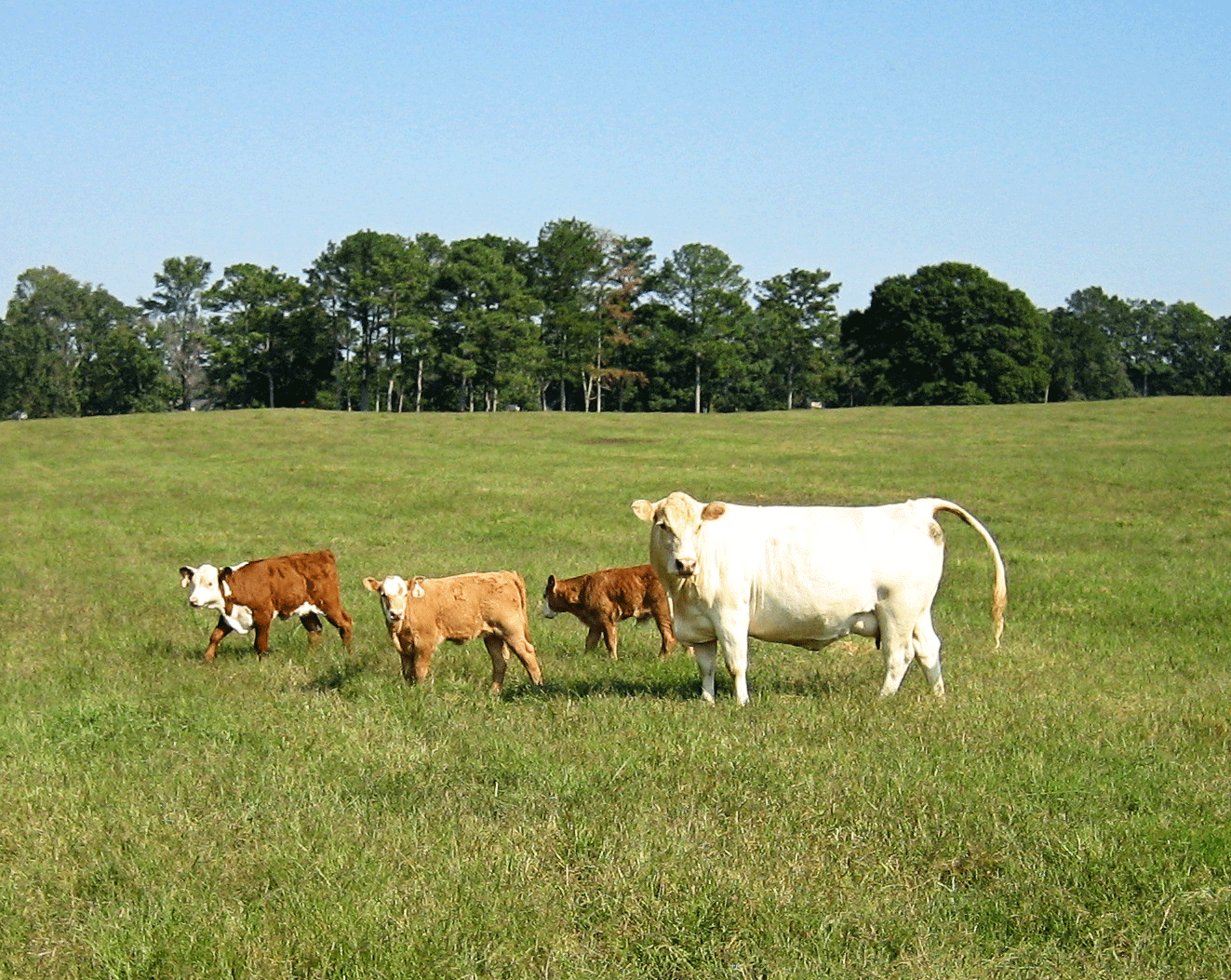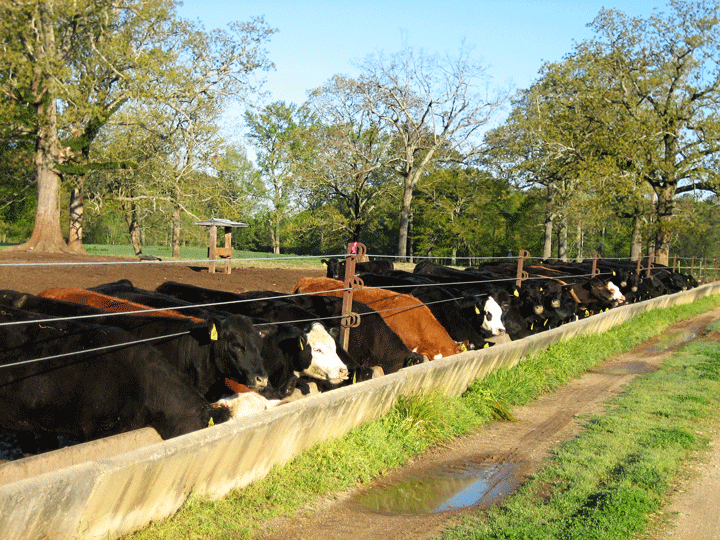
The number of calves sold is a major source of income from a cow/calf operation. A high percent calf crop increases profit. Reproductive efficiency is the first factor to consider in a breeding program. A beef cow must conceive in the first 40 to 60 days of the breeding season, have a live calf unassisted, breed back to calve every 12 months, and raise a calf that is heavy enough to be profitable. To accomplish this, she must be managed correctly. Management factors that influence reproduction include:
- Proper Nutrition
- Adequate Body Condition Score
- Healthy Herd
- Crossbreeding
- Sound breeding practices
- Annual culling and replacement
The following is a step-by-step program to increase the reproductive efficiency of the herd.
STEP 1: Prior to Calving
Research has clearly shown that maintaining cows in adequate body condition helps ensure that cows will return to estrus and breed back within 80 days (the window necessary to ensure a calf per year). Cows maintained on an increasing plane of nutrition prior to calving usually have a shorter interval to their first ovulation than cows on a decreasing plane of nutrition. Proper nutrition prior to calving will help cows initiate an estrus cycle in the first 40 to 60 days after calving. Inadequate nutrition prior to calving will cause cows to delay estrus after calving, thus keeping the cow from producing a calf on a yearly basis.
It is essential to know your cows’ and/or heifers’ nutritional requirements and maintain the proper body condition score (5 = Moderate or 6 = Good) prior to calving. Cattle that are too thin will have problems cycling, as will cattle that are too fat. Body condition scoring (BCS) is a reliable method to assess the nutritional status of a cow herd. The following visual body condition scoring system developed for beef cattle uses a scale from 1 to 9, with 1 representing emaciated animals and 9 corresponding to obese cattle. There is a relationship between body weight changes and body condition score (an approximate 90-pound weight change is associated with each unit change in BCS).
| Table 1. Body condition scores and animal appearance at each condition score. | ||
| BCS | Condition | Appearance |
|---|---|---|
| 1 | Emaciated | Shoulder, ribs and back are visible |
| 2 | Very Thin | Some muscle, no fat deposits |
| 3 | Thin | Some fat deposits, ribs visible |
| 4 | Borderline | Foreribs not noticeable |
| 5 | Moderate | 12th and 13th ribs not visible |
| 6 | Good | Ribs covered, sponginess to tailhead |
| 7 | Very Good | Abundant fat at tailhead |
| 8 | Fat | Fat cover is thick and spongy |
| 9 | Obese | Extreme fat throughout |
STEP 2: Calving
Plan to calve out cows and/or heifers during the year when it will align with major forage growth. This will help reduce the need for additional supplemental feed, enhance milk production and get the cow cycling back quicker for breeding. The major goal at calving is to calve 70 percent or more of your cows during the first 21 days of the calving season. When making culling decisions, select animals that breed and calve early each year. These animals will continue to be more fertile as compared to those calving late in the calving season.
During the calving period it is important to check cows and heifers two to three times a day. Putting cows in a small pasture near your house during calving will help make finding calving cows easier, especially when checking at night. Closer attention needs to be paid to first calf heifers, as they tend to have more calving problems than older cows. Respond quickly if a cow needs assistance during calving. Make sure each calf gets up and nurses.
Collect and record calving data at birth. This information includes: cow ID, calf birth date, calf ID, calf sex, calf birth weight, calving ease and any other helpful remarks. This information can be recorded in a small pocket calving book then transferred to a more secure location such as your computer. These records will become very valuable, especially in verifying the age of your calves.
The cow's greatest nutritional need is shortly after calving. During this period the cow is in peak lactation, trying to regain weight that was lost at or near calving, plus repairing her reproductive tract in order to become pregnant within the next 40 to 60 days. Make sure the cow gets the required nutrients to support both herself and her calf during this period.
Several studies have documented the importance of maintaining adequate body condition after calving and prior to breeding. These studies have shown that increasing the nutritional levels following calving will increase conception and pregnancy rates. The simplest way to ensure cows are ready to rebreed (having regular heat cycles) is to maintain them on a sound nutrition program.

Know the nutrient content of your forages, especially hay. An inexpensive way to be assured you are meeting the animal's needs is forage testing. These results will enable you to make cost-effective decisions relating to supplemental needs for your cow herd. Make sure your cows are getting the proper protein, energy and minerals in their diet.
STEP 3: Breeding
Maintaining a controlled breeding season is very important. It improves the marketability and uniformity of the calf crop, makes meeting the nutritional needs of the cow herd more cost-effective and facilitates better herd management. It also allows for closer observation during the calving season and assists in identifying reproductively unsound cows that need to be culled from the herd. A controlled breeding season usually consists of a 45, 60 or 90 day breeding window. This breeding period can be greatly reduced by following a synchronization protocol and utilizing artificial insemination. Use the correct cows-to-bull ratio during natural breeding: 30 to 50 cows per mature bull; 30 or less for young bulls, depending on their growth and development. Additional bulls (multiple bulls) may be needed to ensure cows get bred quicker; again, this depends on the bull's growth and development. It is extremely important that each bull has an annual breeding soundness exam just prior to the breeding season. Bulls should be also be maintained in adequate nutritional status. Bulls should be strong and in thrifty condition—not fat. It is important to record the date that bulls are turned in and then removed from the herd to be able to accurately determine the calving season.
Plan to breed heifers 30 days prior to the cow herd. This will give first-calf heifers 30 extra days to rebreed and stay within the normal cow herd breeding season. Remember first calf heifers will continue to grow and develop to mature cows until around 4 years of age. To help ensure adequate development and maturity, heifers should weigh at least 65 percent of their estimated mature weight at breeding.
STEP 4: Development
It is critical that the cow becomes pregnant and remains pregnant during this developmental stage. Shortly after breeding or bull removal (35 to 90 days), both heifers and cows should be examined for pregnancy. Because heifers should be bred first, they can be examined earlier than the cow herd. Pregnancy can be determined by rectal palpation, ultrasound examination or blood analysis. The blood test should be conducted at 30 days post-breeding on heifers and 90 days post-calving on cows. Keep in mind the blood test will only confirm pregnancy. It will not indicate the stage of pregnancy. Both rectal palpation and ultrasound examinations should be performed by a skilled, experienced individual—usually a large-animal veterinarian.
All open cows and heifers should be culled from the herd as soon as possible. If a cow is open at weaning time, that means she will not wean another calf for two years. This same period could be used to put a heifer calf into production. Research has shown that heifers that fail to breed the first year and are held over have an average lifetime calf crop of 55 percent, compared to 86 percent for herdmates that become pregnant the first year.
Keeping your cow herd (cows, calves, replacement heifers and bulls) healthy during each of the steps listed above will help assure an improvement in your percent calf crop. Your veterinarian can work with you to develop a herd health protocol for your particular area and herd. Below is a general herd health schedule.
Beef Cattle Vaccination
A. Cows at Late Pregnancy
- Vaccinate:
- IBR, PI3, BVD, BRSV
- Hemophilius somnus
- 7-way Clostridium
- Lepto-5
- Vibrio
- E. coli
- Rotovirus
- Coronavirus
- Deworm / External Parasite Control
B. Cows at Pre-Breeding
- Vaccinate:
- Lepto-5
- Vibrio
- Pinkeye (optional)
- Deworm / External Parasite Control
C. Calf at 4 + Months of Age
- Vaccinate:
- IBR, PI3, BVD, BRSV
- Hemophilius somnus
- 7-way Clostridium
- Lepto-5
- Pasturella hemolytica (optional)
- Pinkeye (optional)
- Deworm / External Parasite Control
- Implant
D. Calf at Preweaning (6-8 Months of Age)
- Vaccinate:
- IBR, PI3, BVD, BRSV
- Hemophilius somnus
- 7-way Clostridium
- Lepto-5
- Pasturella hemolytica (optional)
- Pinkeye (optional)
- Deworm / External Parasite Control
- Implant
E. Replacement Heifers at 8 Weeks Pre-Breeding
- Vaccinate:
- IBR, PI3, BVD, BRSV
- Lepto-5
- Vibrio
- Deworm
F. Replacement Heifers at 4 Weeks Pre-Breeding
- Vaccinate:
- IBR, PI3, BVD, BRSV
- Hemophilius somnus
- 7-way Clostridium
- Lepto-5
- Pasturella hemolytica (optional)
- Pinkeye (optional)
- Deworm / External Parasite Control
G. Replacement Heifers at Late Pregnancy
- Vaccinate:
- IBR, PI3, BVD, BRSV
- Hemophilius somnus
- 7-way Clostridium
- Lepto-5
- Vibrio
- E. coli
- Rotovirus
- Coronavirus
- Deworm / External Parasite Control
H. Breeding Bulls (spring and fall)
- Vaccinate:
- IBR, PI3, BVD, BRSV
- Hemophilius somnus
- 7-way Clostridium
- Lepto-5
- Vibrio
- Deworm / External Parasite Control
Summary
Improving your percent calf crop involves re-examining management practices that influence reproductive efficiency during the year (prior to calving, calving, breeding and during development). Take a close look at each of the management practices: proper nutrition (maintain proper BCS), maintain a healthy herd, take advantage of crossbreeding, practice sound breeding practices, cull annually and develop replacement females annually. Improving each of these management practices and keeping good records is the key to selling more calves each year.
Original manuscript prepared by Dan T. Brown, Former Extension Animal Scientist
Status and Revision History
Published on Jul 01, 2002
In Review for Major Revisions on Feb 03, 2009
Published with Major Revisions on Oct 18, 2010
Published with Full Review on Oct 01, 2013
Published with Full Review on Aug 09, 2016
Published with Full Review on Aug 29, 2022


























































